Swiss Alps Cheesemaking (page 2 of 2)
Home >>
Experiences My visit of a 8000'/2400m high cheesemaking chalet in the Swiss Alps where cheese is still made like 300 years ago - and not one tourist in sight!
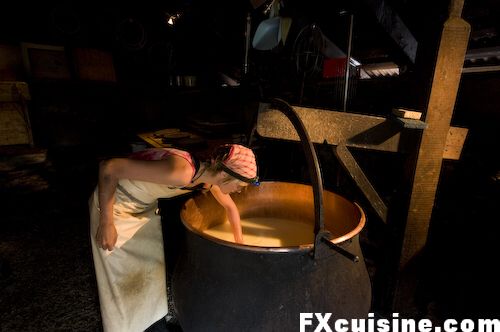
FX, can you close the door, please?, she asks. As the door closes, I can barely see my feet. Fortunately a couple off-camera flashes to help me show you how the cheese is made.
A quick temperature check and Jenny removes the mixer. A hand in the cheese to see if it's really ready ...

... and she dives in like a bird of prey with a huge cheesecloth held between her teeth.
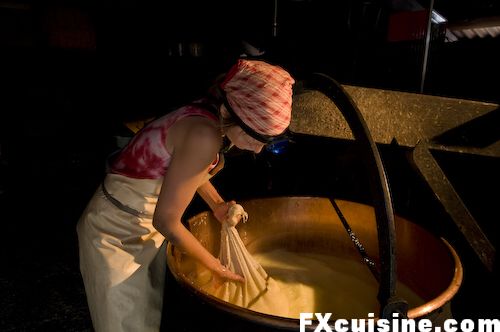
The young cheesemaker pulls up a huge sack of curds...
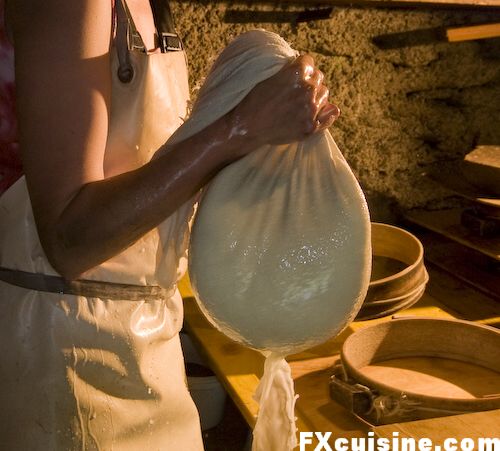
...and she rushes to the table while the hot whey pours out on the century-old stone slabs.
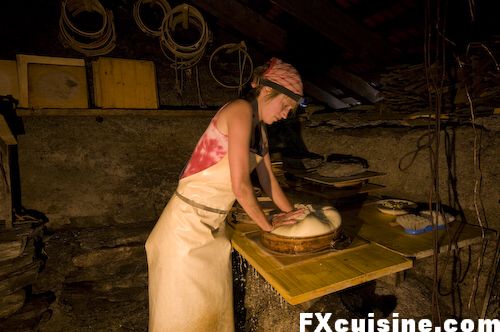
She places the cheesecloth full of curds inside one of the wooden forms and presses for more whey to come out...
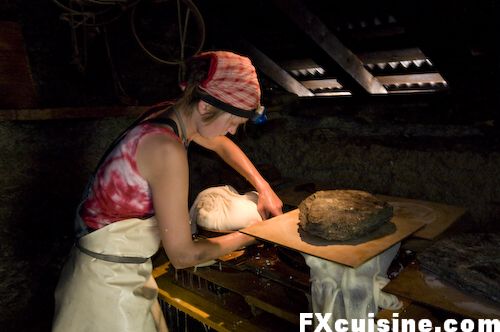
... then covers it with a stone.
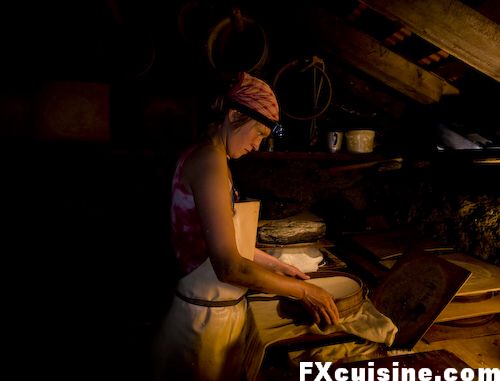
As the curds run out, Jenny works on the cheeses she made the day before. She swiftly removes the stones, then the wooden circles ...
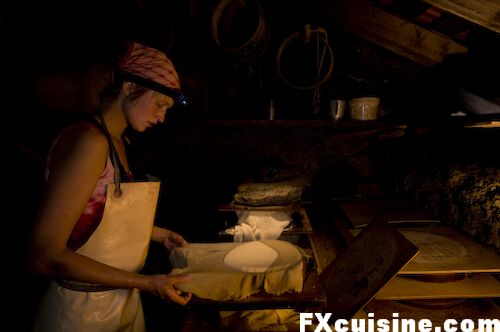
... and unwraps the cheesecloth. Much whey has escaped and the casein has bonded again - the cheese is still soft but holds together...
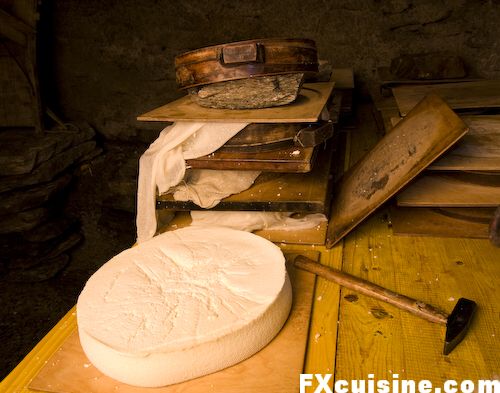
... and can be removed from the form.
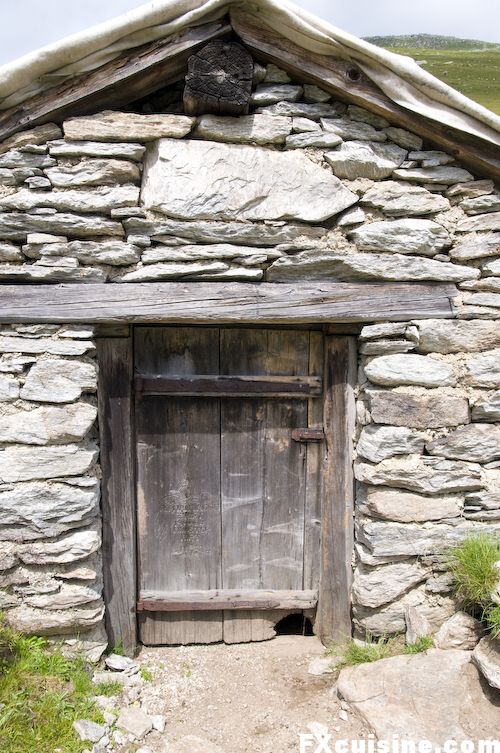
What happens next? The fresh cheeses are carried to a tiny stone hut (above) to start the salting and maturing process.
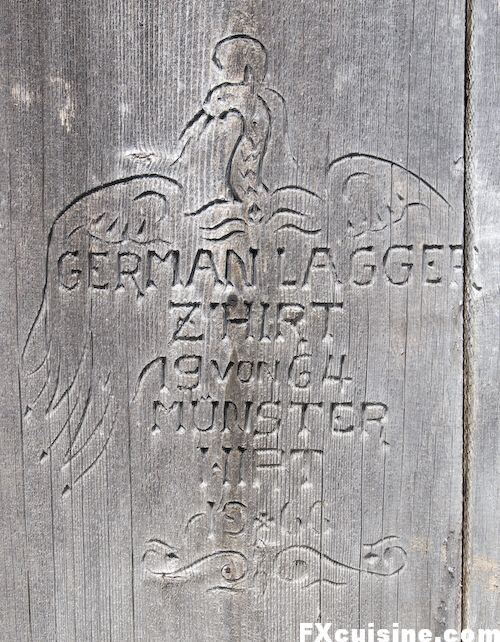
As I draw near, I notice a pattern on the wooden door. It has been carved 40 years ago by the shepherds who lived up there in Vorderdistel.
«German Lagger» are the first and last names of the head sepherd, formerly from Münster, now deceased. Nothing sinister here. Mr «Z'Hirt» was his helper.
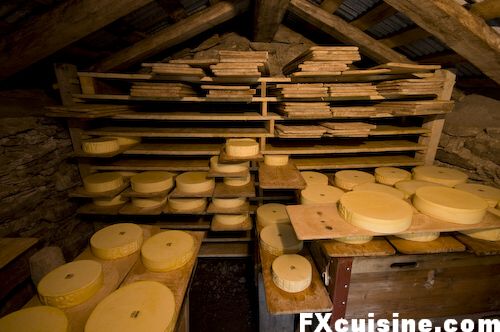
Don't miss the 360° panorama of inside the maturing hut (Macromedia Flash, 2Mb). You'll see the salt bath where the cheese spend their first night on earth, then the wooden slabs where their wait for their daily rubbing. This will go on for a whole year although some people already eat the cheese 2 months after it's been made. During 90 days Christian and his crew produce nearly 1000 such cheeses from their 51 cows, and space soon runs out. Joseph, the farmer, comes up regularly to haul down as many cheeses as he can carry and stores them in a cellar down in the valley. When you drive through the Alps you'll see dozens of these places where you can buy such cheeses. Just stop when you see a sign - you won't be disappointed.
I'll show you the matured cheese next year.
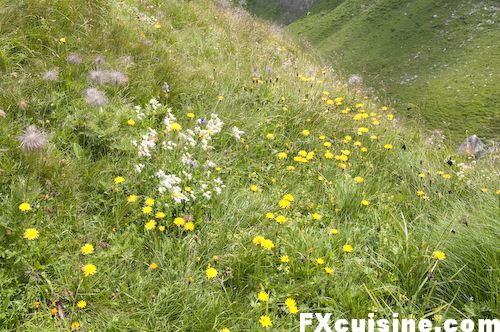
The secret of these high alpine pasture cheeses incredibly complex taste is in the grass. Each plant contributes toward the final tastes. If your cows change pasture, you can taste the change in the milk. It is not mystery - milk is made from water and grass.
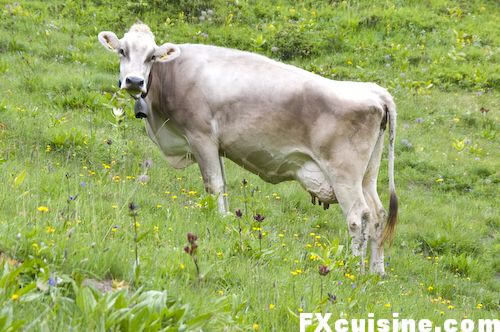
The herd is 51 cows strong, owned by 4 farmers in Münster. Most are the Swiss Bronfi cow and 3 are the famed Evolène fighting cow. They come up for 90 days in late June and visit 4 different pastures/chalet as they exhaust the grass. The rest of the year the cows are down in the village. The cowboys don't come down at all - it's a full time 7-days-a-week job. One farmer brings the food up by foot once a week. In 90 days they produce about 1000 big cheeses. The cheeses are sold privately starting in September.
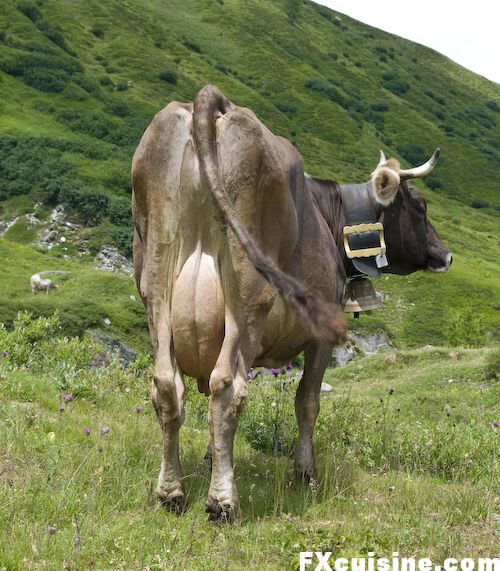
Thanks to Jenny, Christian & the other cowboys up there in Vorderdistel for their warm welcome, to Joseph Werlen and Herr Imoberdorf for helping me plan this and of course to Johannes for his invaluable help on lighting.
832763 views
Related Articles Hard Core Swiss Vacherin Cheese ***
Hard Core Swiss Vacherin Cheese ***
Follow me as I wake up in the wee hours of the morning to see Swiss armailli make a unique cheese in a small chalet up the Gruyere Alps.
 Montgomery's Cheddar ***
Montgomery's Cheddar ***
My Christmas article will show you how the best cheddar since King Arthur is made in Somerset, including a 4 minutes video.
 Swiss Alps Ricotta ***
Swiss Alps Ricotta ***
See how we make sérac, the Swiss ricotta, up in the Swiss Alps and learn about about Swiss cheese botanics with a field trip to see what the cows graze up there.
 Swiss Raclette ** Popular
Swiss Raclette ** Popular
The national dish of Valais, my Swiss canton, raclette is the most gorgeous melted cheese you will ever have. Here at its best at the Manoir de Villa in Sierre.
 Primeval Tyrolian Cheese **
Primeval Tyrolian Cheese **
Graukäse is the closest offspring of the first cheese ever made. It is so strong you can actually raise the dead by placing piece under the deceased's nose. Follow me to Valle Aurina in Südtyrol to see how it's made at the farm.
Most Popular ¦ Most Recent ¦ By Subject ¦ Last Comments
External Comments
«Today, I came across a wonderful set of photos [...] by the very talented photographer François-Xavier. He travels and photographs and writes about food. His photos are so rich and varied and do that thing that amazing photographers do of capturing the moment and the feeling of that moment just perfectly. They have a painterly feel almost like a still life which somehow seems so appropriate for showing people working with food using methods they love.» FUCheese 15/04/2009
Copyright FXcuisine 2025 - all rights reserved.
If you do this recipe at home please let me know how it worked for you by submitting a comment or send me a picture if you can. Thanks!

























61 Comments
- #1
- Comment by Wotchers
What a brilliant article! Amazing photos too, as always.The scenery up there is stunning - I can almost smell the freshness of the air and all those wonderful alpine flowers.
Still, I hope all the young cheesemakers get paid well - it sounds a very tough 90 days!
Did you manage to carry (or roll!) a cheese back down the mountain to eat yourself?
- #2
- Comment by Jennifer
Wow! Thanks for treking up the Mtn. to show the cheese making. It is a skill I am learning in New Mexico, USA. Your photos are very helpful as well as beautiful. Keep up the great work! I enjoy checking into FX to see what you are up to because your beauty and creativity always inspire me! If you ever come to the American Southwest feel free to contact me, and I can show you our reginal chile pepers unique to NM.- #3
- Comment by Luci
Thanks again, Francois. What beautiful scenery and insightful commentary, as always! Thank you!- #4
- Comment by Shu
DO they make just one kind of cheese? What sort of cheese is that?- #5
- Comment by babyg
It's excellent looking at all the different locations that cheese is made in; the scenery here is astonishing! An arduous journey, but the view looks totally worth it.I've been checking every day for your new article, your pictures and recipes are always so lovely! I always get so excited when you put a new one out^.^
- #6
- Answered by fx
Babyg, thanks for visiting! I publish my article twice a week, every Monday or Friday unless there is fire in my kitchen. Soon there will be more articles about Alpine cheesemaking - hold tight!- #7
- Answered by fx
Shu, they only make one sort of cheese, which does not really have a proper name. We call it 'Fromage d'alpage' or 'Alpkäse', which is "Alpine Cheese". It is close to a raclette cheese and great for melting. Each alpine meadow cheesemaker makes it a bit differently. See my raclette article to see how it is used!- #8
- Answered by fx
Luci, the scenery was OK but there are nicer valleys in the Alps. It's really great to visit such a place that can only - really only - be reached after a couple hours on foot. I really wished I had a donkey that day!- #9
- Answered by fx
Jennifer, I love the cuisine of the South West United States and have a giant Oklahoma Joe offset cooker in my garden. I even get Fiery Foods every two months, published in Albuquerque. Would very much like to visit once!- #10
- Answered by fx
Wotchers, thanks for your nice comment! The air up there is fresh, no doubt, at least until you step inside the cheesemaking hut when the fire is on. Then your eyes start burning and you rush out before you collapse on the floor. Smoked blogger is the specialty.The cheeses need to be matured for a couple months and I'll buy one in late September at the soonest. They are best 10-12 months after they've been made.
- #11
- Comment by Alex
That looks amazing! - I'm about to start university in Lugano in september - does anyone know of a chalet in the region (Ticino) or one near Lugano? Grazie!- #12
- Comment by Marie-Louise
Loved your cheese-making article - grew up in Switzerland until I was a teenager, then migrated to Australia with my parents in the early 70's - Your article brought back childhood memories of Alpenkase and that ice-cold milk you could drink from the large bowls in the Alpenhutten. Wish I was there to taste the cheese next year - will look forward to that article.ML
- #13
- Comment by Traci ~ Soup of The Day
Your posts always remind me I need a vacation from this big city. :)- #14
- Comment by Ouroboros
Absolutely beautiful.I've been following your site for quite a while, FX, as you know.
I propose a change of title from "blogger/chef" to "photojournalist/chef"! Great work!
O
- #15
- Answered by fx
Alex, there are cheesemaking chalets all over the Alps, however in September the cows go down until next June!- #16
- Answered by fx
Marie-Louise, I am glad my little article brought back cherished memories of your drinking cold milk in a Alpenhütte!- #17
- Answered by fx
Traci, when I reached my car after hours of walk and being smoked in the alpine hut, I longed for a vacation ... in the city!- #18
- Answered by fx
Ouroboros, thanks for the kind words. Yes I'm trying to develop my reportage skills with off-camera flashes, available light is just not enough when none is available!- #19
- Comment by Cynthia
You take me on journeys and show me places and things I would never be able to see from my corner of the world. Thank you.- #20
- Comment by JIm McDish
What an absolutely beautiful place. I would love to go hang out there for a lifetime!JT
www.FireMe.To/udi
- #21
- Comment by Aaron
I'm really a sucker for landscape, so your pics are great! However, I'm also a huge cheese addict, so I'm in danger of the drool shorting out my keyboard... :)~One question though.....how do they keep the rodents out of the maturing hut?
- #22
- Comment by Paul S
How awesome. It makes me miss Switzerland. I visited Bellinzona and Lacarno in the canton of Ticino last year and I've been dreaming about it since. I tell everyone "I hated Switzerland" when they ask. Then, when they wonder why, I reply, "Because it's one of the most beautiful places on earth and I can't go back for a long time."Thanks for the reminisce.
- #23
- Comment by Cow
Blessed are the cheese makers...- #24
- Comment by Jeff
That was great, thank you! I hate to ask a geeky question in the face of this centuries-old practice, but with what did you compile that 360 panorama - it's one of the best implementations I've seen.Thanks!
- #25
- Answered by fx
Jeff, thanks for visiting! You can see more of my 360 panoramas by clicking on the "360 panorama" keyword at the top of the article. Basically I put a 10.5mm Nikkor fisheye lens on a Nikon D300, then screw this to a 360Precision Adjuste head, which is then screwed to a Manfrotto tripod. That's already a good 30 pounds of gear to carry. Then 6 pictures across, one up and one down. Back home, Lightroom to extract the Raw files, then I stitch in PTGUI, then split in 6 images with QTVR converter, and finally publish with Flash Panorama Viewer. Once you know how to do it, it's not too hard provided there is enough light and people are not moving. Hope this helps!- #26
- Answered by fx
Paul, thanks for your sincerity!- #27
- Answered by fx
Aaron, they just don't sell any hiking gear to rodents in Switzerland and that does the trick! At this altitude the only rodents are marmots, and the door is too tightly locked for them to get in.- #28
- Answered by fx
Jim, I think the charm of the place would fade off as the rain starts pouring and then converts to snow! There have been real cases of cabin fever in Switzerland in centuries past, much like Mr Nicholson in the movie Shining, they get crazy and whack everybody. It's much safer to go up in the summer and safely come down to the valley in the fall.- #29
- Answered by fx
Cynthia, would you consider doing the same and showing us how fishermen catch fish in Barbados and roast it on the beach? That would make for a terrific read!- #30
- Comment by cilla ehly
Oh....So Wonderful! I am mezmerized by the cows and imagining their bells echoing and blending with the winds as they slowly and deliberately eat through their lovely alpine meadows. Viva Slow Food! Viva the beautiful cheese makers and their 90 day zen devotion. May you travel well and thrive.- #31
- Comment by Alfred Estakis
This people seem to have a lot of fun. I wonder if, their cheese is salty of creamy or perhaps they ad some natural mints to it.- #32
- Comment by Ben McDougal
I would eat all that cheese, I wouldn't move anything for a month... But I would eat it all!- #33
- Comment by Tony K.
Great article and great pictures. Is all the milking for this cheese done by hand?- #34
- Comment by Laura C
All I can say is AMAZING!!- #35
- Answered by fx
TonyK, they use a machine for milking.- #36
- Answered by fx
Ben, that's a thousand cheeses in 90 days - can your liver survive?- #37
- Answered by fx
Alfred, the cheese is quite creamy in the first 6 months, then gradually becomes more pungent.- #38
- Answered by fx
Cilla, thanks and hold on for more Slow Food articles!- #39
- Comment by donsiranni
Great stuff,always hoping for more Swissy-don't forget my dried/cured alpine meats request.History was never this much fun.- #40
- Comment by parshu.narayanan
Lovely! Cant wait to visit, buy & EAT!- #41
- Answered by fx
Parshu, you can visit or buy and eat, but not at the same time as these cheeses are then transported to a remote location for long term maturing, which takes up to a year. The little shack is only the week's production!- #42
- Answered by fx
Donsiranni, I have not Swiss dried meat for you yet, but I have found a really awesome Speck in Südtyrol. That's a whole pig, not just the fat big, sliced, boned, spiced, smoked and air-tried for a year. Hold tight, this one is right up your alley!- #43
- Comment by elarael
So lovely, this post, in so many ways! Wow. Only recently discovered this blog and looking forward to reading more. Many thanks for sharing!- #44
- Comment by Marie
What an amazing blog you have, I just love the pictures! I feel that I have experienced cheese making in the Alps through your photo's, I'll definitly be back for more!- #45
- Answered by fx
Marie, thanks for your kinds words! A lot more is coming on Alpine cheesemaking, and then some more about Cheddar.I visited your blog and love your pictures, so vivid! What sort of light do you use?
- #46
- Answered by fx
Elarael, thanks for dropping in and glad you liked my blog! Use the keywords/tags to find more articles like the ones you like, I have now over 200 articles and 2 more every week!- #47
- Comment by Christine Hyatt
Absolutely stunning photos and a peek behind the scenes that one rarely gets to enjoy. I work in the cheese industry and truly enjoyed seeing the true Alpine cheesemaking experience. Love it. Will check back more. Do you now if any of the finished product makes its way to the US?- #48
- Answered by fx
Christine, thanks for your kind words! Apparently none of this cheese gets exported, I'm not sure they US health inspector would let it in anyway. The smallish quantities produced seem to be absorbed all by the Swiss market - man are we fierce cheese-eaters! Hold on for another article about a different type of cheese, this time made by three guys in the Gruyère.- #49
- Comment by Stephen
Absolutely inspirational!- #51
- Comment by Alex
I am writing from Armenia.I enjoy your site and articles. I can just imagine myself there by just looking at the pictures. I am familiar with the life of shephards in the pastureland of Armenia. I used to manufacture natural dyed carpets with handspun wool. I can't do it any longer after the fall of US$ in value.
I used to go to pastureland in the summer time to buy wool from the shephards. I have spent nights in the tents of local shephards. No lights, no sewer or any other trace of city life. There would still be snow left on the ground at the end of July and it would be exteremly cold at nights. This pasture is about 3200 meter above the sea level.
The shephard dogs would bark all night long trying to protect the sheep from the wolves. The sheep would be milked early in the morning and in the evening.
This particular pastureland that I had been to has a very different vegitation. Ther is hardly any grass and it is mostly flowers and other types of vegitation. The shephards used to tell me that the quality of the milk is much higher in this pasture. Some shephards would bring their cows along with them.
The cheese making in Armenia is very primitive. It is called panir and this name is used throughout Iran and India and it is Peynir in Turkish. Only rennet is used in making it.
I have been thinking of the idea of making Alpine style cheeses. I have ordered the cultures and rest of the necessary stuff. I will be using cows milk from this pasture next summer.I also do have copper kettles that I used to use in natural dying of wool. I have been reading how important the use of copper kettles are in Swiss cheese making. Most people in Armenia think that copper can cause poisoning unless the interior is coated with tin
Should I be worried about this ? I do have six kettles which are around hundred litres each.
I would also like to send some pictures of this pasture to you if you provide me your email address
- #53
- Comment by Danilo Ibarra
FELICITACIONES:Interesante tu reportaje, deseo comentarte que soy originario de una provincia de Guatemala Centro America, llamada Coban y se asemeja el clima y la actividad lechera y productora de quesos a Suiza, y que importante saber del esfuerzo que realiza Jenni y su colaboracdores para producir estos exquisitos QUESOS en nuestro medio no es tan rudimentario el sistema de produccion aunque si hay procesos mas tecnicos QUE DIOS TE BENDIGA EN TU TRABAJO
- #54
- Comment by Hernan Coregoso
Me parece excelente el trabajo sobre la fabricacion de quesos en Los Alpes. Yo hago vinos en Mendoza Argentina, y estoy estudiando la posibilidad de hacer algo parecido con quesos en Los Andes. Si pudieras contactarme con Jenny y Christian los invitaria para ver si no quieren venir una temporada a hacer quesos en las montañas Andinas. Quizas podamos inventar algo interesante. Espero algun día probar esos quesos.Un fuerte abrazo
Hernan Cortegoso
- #55
- Comment by Ranu Ali
It is wonderfull experience, in India we started to taste cheese more recently but we love this but india is hot country there is not availble variety of cheese, but may be one day I like to come in switzerland and tast your cheese.- #56
- Comment by Rick
Can you recommend an alpine cheesemaker that takes one-day visitors.(paying of course)- #57
- Comment by Collection Agency
This cheese making is actually making me drool. Simply amazing so glad I click the link. Now I am going to go smother something in cheese.- #58
- Comment by steve shapson
Love the copper kettle. Must be quite old. Must book a tour soon to see your operation. Be well.- #60
- Comment by Vina
LOVE MMMAC N' CHEESE! Whenever i'm in Dowtown Boston/ Faneuil Hall area and I don't bring mmmac n' cheese home Im in truoble w/ the wife, kids and Grandma.. we all love it! My faves have to be BBQ/Buffalo Chicken Mac, Cajun Mac (Sausage, peppers, onions, Cajun spices) bacon mac, seafood mac. In addition to the great food, great service, and great value is that they prepare your meal in front of your eyes made to order even the family platters that serve up to ten ready in 10min, I don't know If that's important to other people; it's definitely important to me. Best mac n cheese, best place to eat in Quincy Market. Enjoy!Tell me what you think!
Write a comment below to let me know what you think about my article or ask any question you may have.